|
|
Post by sd on Aug 13, 2011 8:09:15 GMT -5
This thread will be focused on ETF's - and not individual stocks.
ETF's today offer something for everyone, with many being very liquid-and leveraged ETF's can bring both more gain, and more pain.
Ideally, other members will also make this their thread,
(i'm just opening it) and take the time to contribute their trading ideas using ETF's. we can get a good exchange of ideas and information that should be beneficial to all.
It does not matter whether the approach is short term swing trading, or long term holding- or anything in-between!
|
|
|
|
Post by bankedout on Aug 13, 2011 9:40:12 GMT -5
I just want to add that the leveraged and inverse ETFs are designed to track performance on a day by day basis. If you are a day trader and never hold a position overnight, they should work as you would imagine. However if you try to hold them for longer periods of time, their performance can change drastically from whatever they are tracking. It is important to understand them before you use them.
Also there are products that track commodities by way of the futures market. These products can drastically diverge from their commodities performance. Oil could go up big for 4 months and the oil ETN may go down during that time period.
Speaking of ETNs, they are essentially promises from a bank, so if that bank runs in to trouble, theoretically you could lose everything.
All of this being said, there are many great products to trade. If my broker wasn't changing ownership this weekend I would share some of my watch lists and reasons for watching these particular ETFs.
|
|
|
|
Post by sd on Aug 13, 2011 9:43:24 GMT -5
GOLD is viewed as a currency of it's own, a flight to safety in times of uncertainty, and has been trending well over the past decade,. just making a new high this week. Estimates for where gold will price out continue to be raised as the market sees instability in the European financials, and the US downgrade and spectre of recession/depression. Gold does not always act as a flight to safety- When the market crashed in 2000-2003, Gold started to trend higher after a decade of being a losing trade while the market gained and made new highs. , (gold lost 40%) . Gold rallied and started it's new trend higher in 2001, with several short-lived but noteable pullbacks in times of market fear. Most recently, in 2008 when the market sold off until 3-2009, Gold also sold off losing 30% in 9 months before bottoming and making a new trend higher. This suggests to me that Gold cannot simply be assumed to trend higher if the market sells-off. It does not always act as a safe haven in a falling market- What forces are at work to make it be a safe haven in one market pullback, but not in another? Suggests traders should not assume that it will be the place to go to. At the present, Gold is making new highs and has broken higher on the near term weekly trend line. Gold can be traded through GLD, as well as 2x long and short funds- There are several of each - Don't know the differences- 2 I look at and trade UGL, and DZZ (inverse short) 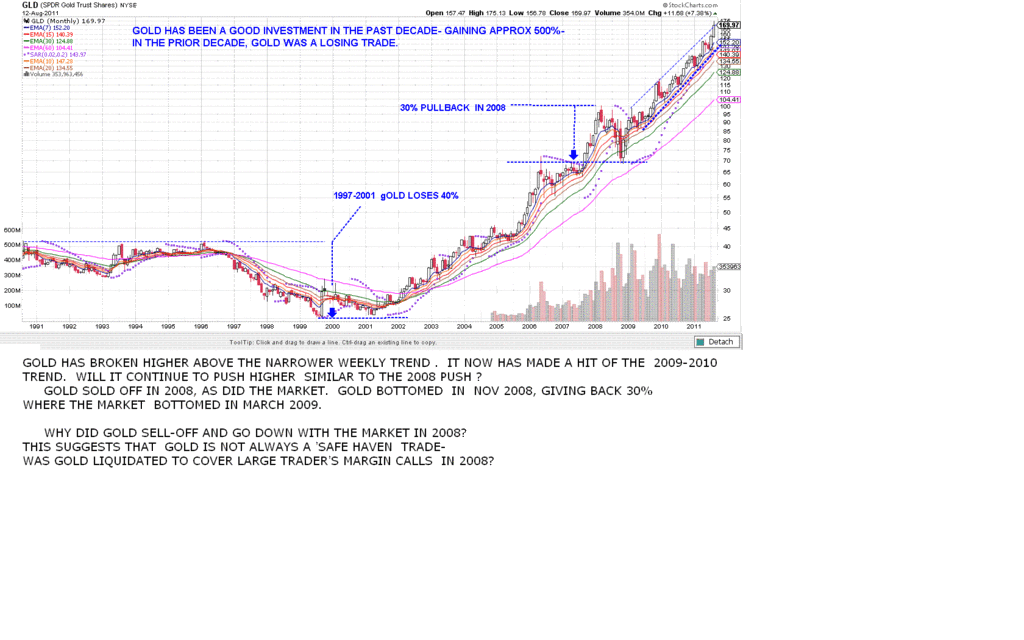 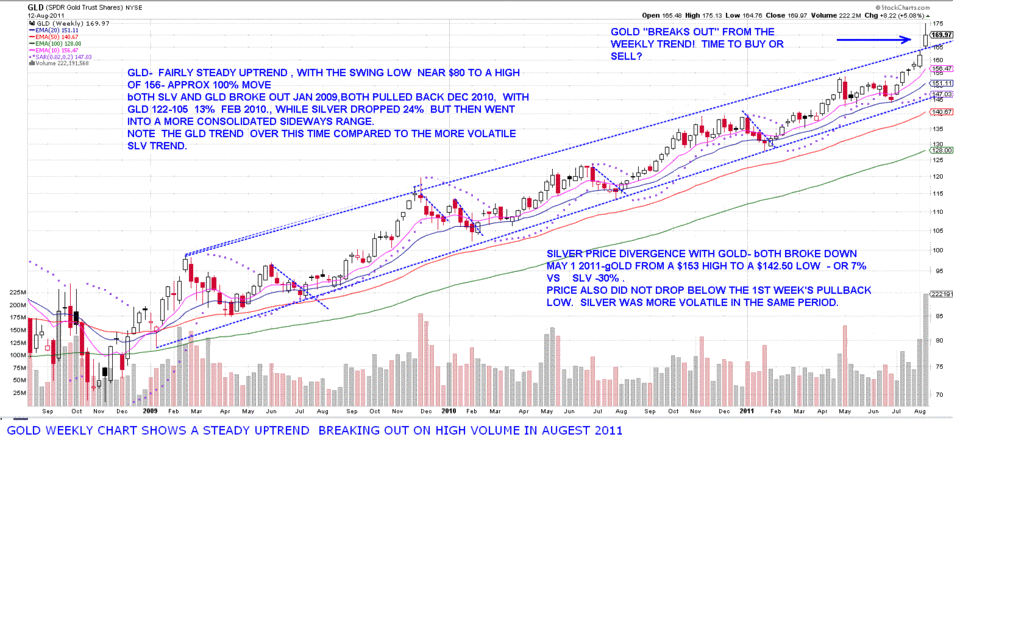 |
|
|
|
Post by sd on Aug 13, 2011 9:55:55 GMT -5
I just want to add that the leveraged and inverse ETFs are designed to track performance on a day by day basis. If you are a day trader and never hold a position overnight, they should work as you would imagine. However if you try to hold them for longer periods of time, their performance can change drastically from whatever they are tracking. It is important to understand them before you use them.
Also there are products that track commodities by way of the futures market. These products can drastically diverge from their commodities performance. Oil could go up big for 4 months and the oil ETN may go down during that time period.
Speaking of ETNs, they are essentially promises from a bank, so if that bank runs in to trouble, theoretically you could lose everything.
All of this being said, there are many great products to trade. If my broker wasn't changing ownership this weekend I would share some of my watch lists and reasons for watching these particular ETFs.
Good points! UNG is a particularly good example of a bad etf in relation to the way it gets rebalanced vs Nat Gas-
As you pointed out in another thread, FCG is a better way to go long nAT gAS.
Over the course of this thread, hopefully the best and worst of ETF's can be discovered for our trading advantage.
This thread will benefit greatly by your shared watchlists!
|
|
|
|
Post by sd on Aug 13, 2011 10:42:11 GMT -5
|
|
|
|
Post by sd on Aug 13, 2011 11:42:47 GMT -5
with the market selling off, and then up 1 day and down 500 the next, and then back up...... I wonder if the sell-off is close to a bottom, and a good buying opportunity, or just a near term oversold bounce? These 2 trades are based on early entries and reversal of the recent trend- Long EEM vs short EUM 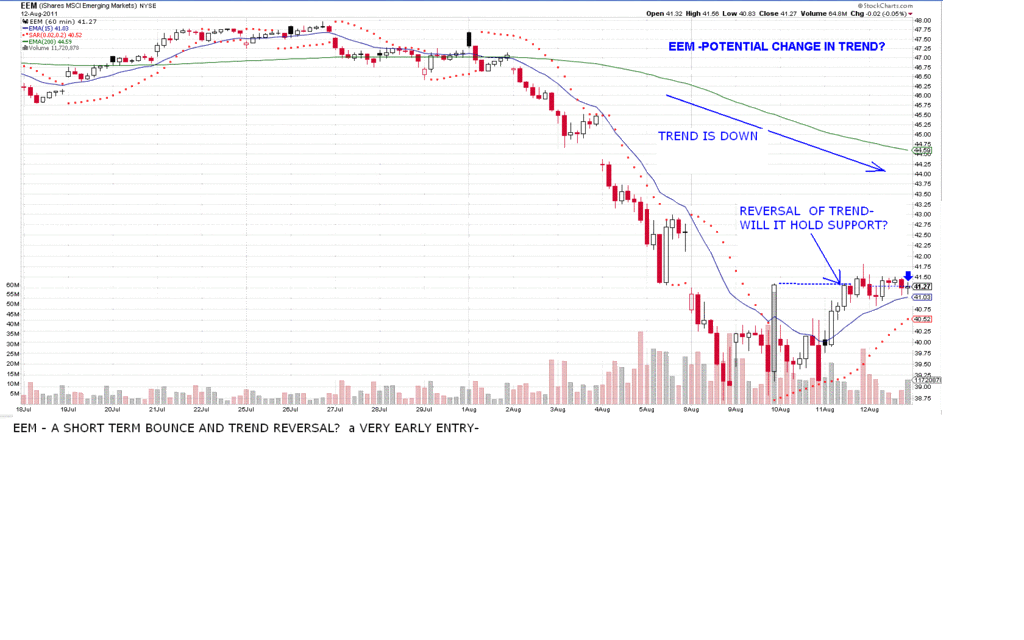 Leveraged Financial ETF- UYG ultra long; skf ultra short (2x) I was at the computer intraday Friday- Took a chance on market direction, entered a day trade using the 3x financial short Faz- Financials are selling off hard in Europe the past weeks, and have been declining here in the US mkt. It does not appear there is any good news for the broad financial market- Don't usually trade the highly 3x leveraged etfs- Sold 1/2 at the close, holding 1/2 over the weekend with tight stop and limit sell- 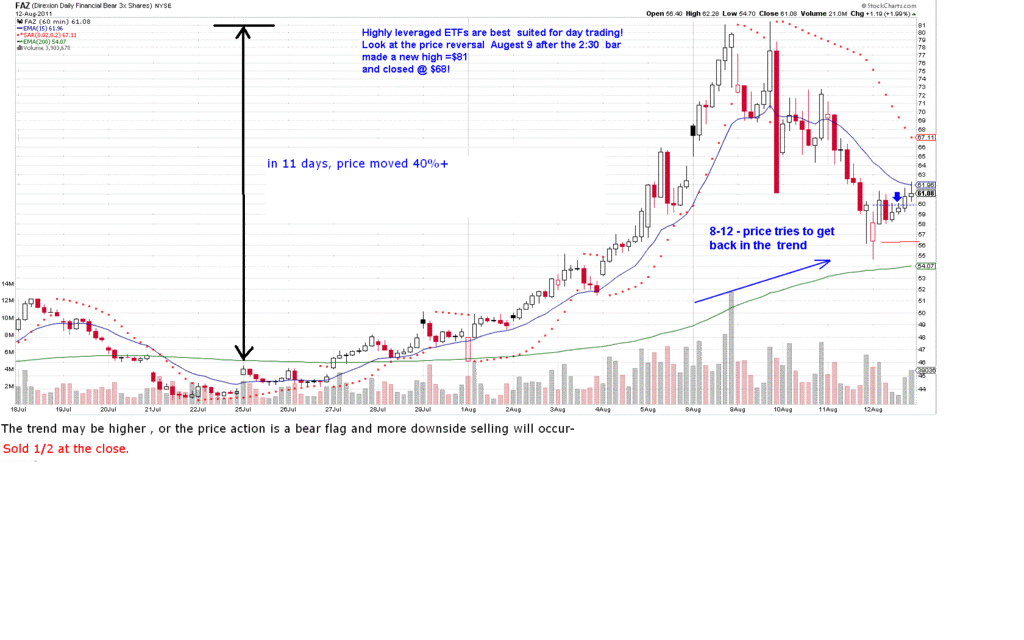 |
|
|
|
Post by sd on Aug 16, 2011 19:41:03 GMT -5
|
|
|
|
Post by sd on Aug 21, 2011 10:08:37 GMT -5
WWW.worden.com -TC2000 is the charting program- has a number of webinars. "On building a watchlist" is a webinar about mostly etf scans and some of the approaches the speaker uses to trade.He includes his basic TA analysis with some moving averages and perhaps an indicator or two- mostly the focus is price action. He also touches upon always limiting his risk with trailing stops. The webinar is :http://www.worden.com/Webinars/05_03_2011 He has 2 subscription services- One focused on ETF's WWW>onlyetfs.com and the other is sectorexchange.com/ Which offers actual trade recommendations, stops and has a focus on Risk control- They also have annuity and no-load mutual fund info- You can view tutorials on each site as to what is provided. His goal is to make 1-2%/month without taking undue Risk, The actual trading results are posted and updated-
|
|
|
|
Post by sd on Aug 21, 2011 10:58:13 GMT -5
TMF- A 3x leveraged treasury bull - TLT is the treasury 20 year - 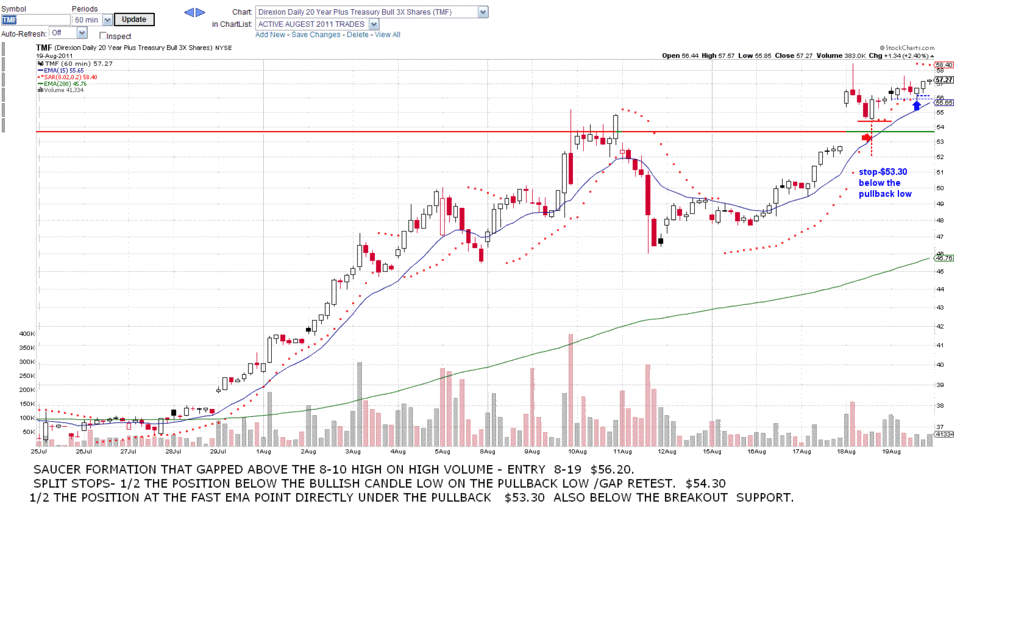 |
|
ira85
New Member
Posts: 837
|
Post by ira85 on Aug 21, 2011 15:46:51 GMT -5
Thanks for starting this thread and giving us some good info. Two small bits to add. I often check ETF Screen www.etfscreen.com/for ideas on what is trending strongly. On the homepage click RSf Trends for listings by relative strength. Good for spotting what's hot. Secondly, one ETN is very hot right now is RTSA. It's leverage short the Russell 2000, but leveraged by how much seems to be a mystery. The iPath website doesn't say how much leverage is employed. At least they don't say how much in the opening paragraph. They just say it's leverage. Maybe the amount is buried in the fine print somewhere. But it should be more transparent. We should have more of an idea what we're getting into. I wouldn't buy not knowing how much leverage is involved. It's clear from a chart that it's extremely volatile. -ira |
|
|
|
Post by sd on Aug 21, 2011 20:23:48 GMT -5
Thanks for posting and the Link IRA ! I believe RTSA is a 3x leveraged play on the Russell. (wrong!) From the wed gap to the Friday close the $RUT moved 7%, while RTSA moved approx 19% in a quick calculation. The leveraged ETF's can mean more gain or more pain! How long can one trade a leveraged ETF against it's base ETF before the EOD rebalancing of the leveraged shares? The way to compare is to go back and look at moves of the underlying over a period of time and compare that to the leveraged play. And it could well be that some leveraged plays do indeed track well over a longer period of time than some others- This would also apply to the 2x leveraged plays- It would be in one's best interest to back test the price action to see how long the leveraged play performs properly. Lets look at $RUT and RTSA on a weekly chart over a few years, comparing the moves within specific time frames- Just realized the leveraged RTSA has not been around that long-when I brought the chart up. I think the process of comparing price moves of the underlying to the leveraged should be prudent though. Leveraged are not touted as being long term instruments- I took the 5-1 open of $rut @ approx $864 with the $651.70 close on 8-19- this is a loss of 212 points or -24.5% RTSA 5-1 open $$20.40 8-19 close $63.16 = +$42.76 gain = +209%- this would be a factor of 8x! OK, I was expecting to see RTSA up approx 75%- 3x the loss the $RUT sustained. I cannot find my error - I've checked my calc's twice- Maybe it's just late- Something that could gain you so much could just as easily wipe you out- Where would you set a stop-loss ? at 50%? Right now I'm long several leveraged funds- UGL, TMF,SKF, with UGL and SKF 2x 'ultra' funds- TMF is 3x. Along with the leverage, one has to be ready to accept magnified volatility - and that includes where one would set a stop-loss- I expect. The extremes of any single move can or will be exaggerated- This is causing me to reevaluate how i have tried to use some of these leveraged positions-. Great if you're on the right side of the trade- but look out if you're wrong! Thanks again for posting! Ideally more members will share their approach if they use ETF's, or ask questions that some can answer- I personally am trying to narrow my trading universe down- to eliminate most discretional stock trades, and focus primarily in ETF's- 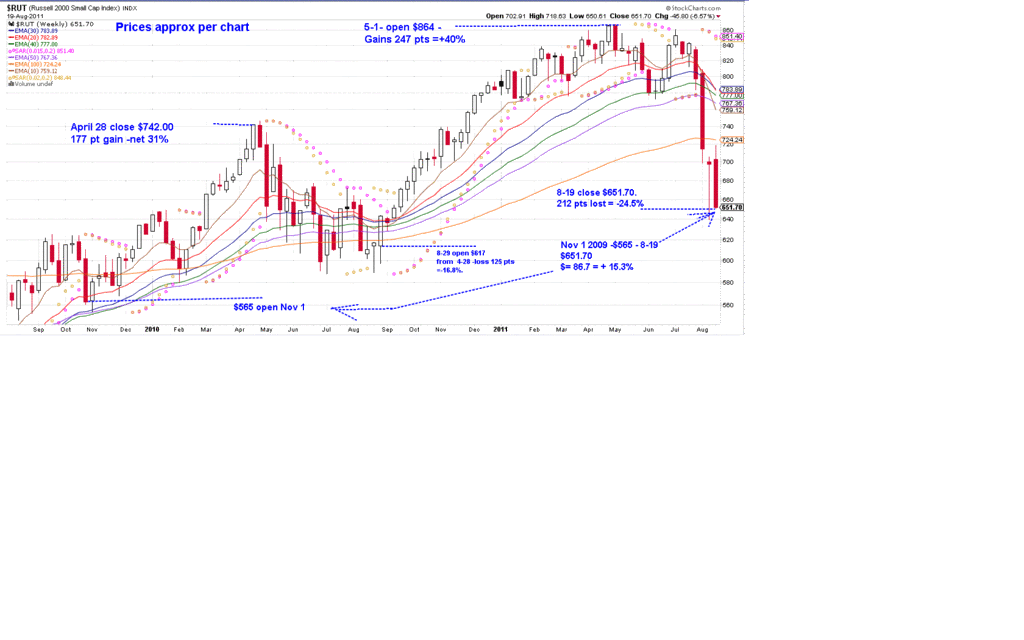 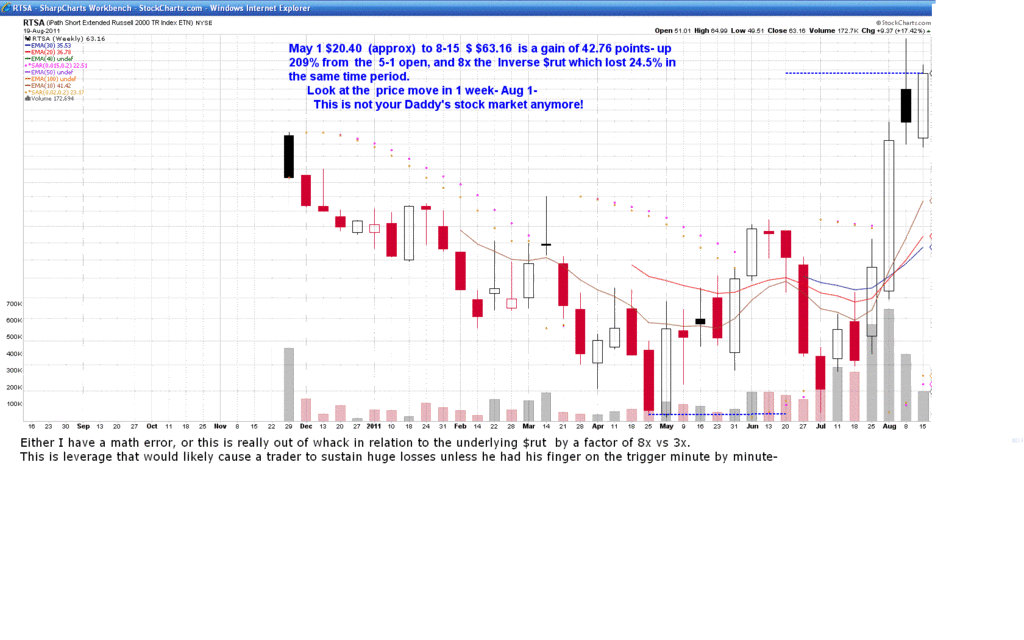 |
|
|
|
Post by bankedout on Aug 21, 2011 20:26:40 GMT -5
About RTSA finance.yahoo.com/news/ETF-Spotlight-iPath-Short-ETFTrends-3268680286.html?x=0&.v=1"“The information at the iPath site makes it difficult to determine exactly what the leveraging factor is — you should be able to find that type of information very easily right after going to the site,” commented Ian Naismith, portfolio manager at Sarasota Capital Strategies, in the Barron’s report. Naismith also notes that recent movements reveal that RTSA has been showing returns of seven to eight times the inverse of the Russell 2000. “It’s levered to extreme levels. Whether that’s by design or not, it’s the most wild inverse fund I’ve seen so far,” added Naismith." |
|
|
|
Post by sd on Aug 21, 2011 20:54:36 GMT -5
Thanks Bankedout!
(glad i can also still do basic Math)
Ira's point about understanding what one is trading is extremely true in this environment , and with this type of leverage-
I don't know if by design these are not fabricated for the benefit of the machine trading programs that can take advantage of small but magnified moves- Or the most sophisticated of day traders....It sure as hell isn't for the investor these things are out there-
How much market pressure on the underlying could this 7x or 8x leveraged ETF cause- Or is it the reverse?
Do these leveraged ETF's put undue pressure on the index or underlying component?
I suspect this would be so- magnifying the extremes of any "normal" market move - akin to the pull exerted on tides by the Moon- an external force that causes influence ....Perhaps not the best analogy -
If these leveraged funds are able to "push" the market down- further than normal demand would call for- Why do we have them? If they exaccerbate a sell condition , they add to the down momentum- Or do they trade in a separate universe from the normal market?
|
|
|
|
Post by sd on Aug 26, 2011 19:50:17 GMT -5
Following up on GOLD- Weekly Chart of the GLD- Looking at a weekly chart to get a sense of price action and support levels- look at the times price got volatile- and the following pullback reaction-accompanied by high sell volume- Because it has occurred before does not guarantee it will do so now, but TA suggests that the odds are that it will. Despite my strong expectation of a further pullback, today's intraday price in Gold generated a 'Buy' signal- that I'm required to take. As I was looking over some of the details of the chart, I noticed that Gold also sold off some 30% in the market sell-off in 2008- Granted, Gold rallied sooner than the market, and had since kept uptrending. But I wonder the "Why" Gold didn't have the market pushing it higher when the financials were in such disarray in 2008/9- Why was there any pullback in Gold at all during that time of Fear? 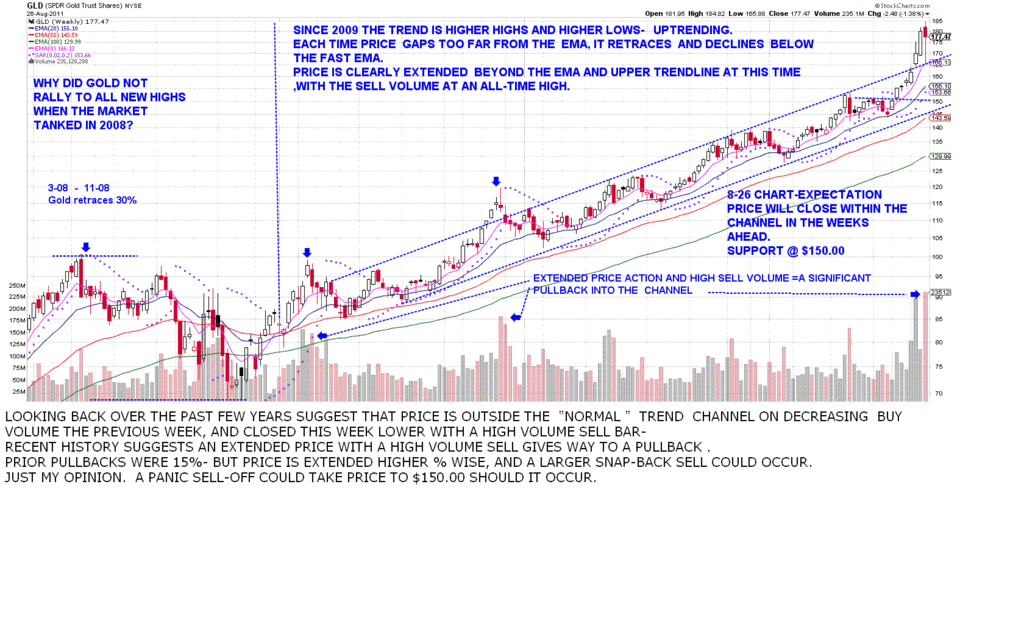 |
|
|
|
Post by sd on Aug 28, 2011 15:20:16 GMT -5
I like the screening tool that can be found at the link IRA posted www.etfscreen.com. Ira mentioned trading with RS as a factor. and that free site offers updated RS rankings, and more- as well as different sectors etc. Lots there to get familiart with. Under the related sites category on the bottom left of the home page was a link to another site www.buydonthold.com/-----by Les Masonson- He has written a book with a complete method for trading within the ETF universe. And keeps a blog site there- I'm getting techie here as I went to amazon, Read the mixed reviews- then downloaded a kindle reading app onto my old desktop, read the free first chapter and then went ahead and ordered the online version of the book for under $10. He starts by narrowing the trading universe to under 100 ETFs with a mix including some bond funds- trying to get exposure in most categories- Then he outlines an approach to testing the market waters by looking at half a dozen market indicators, and then make a determination to go long , sit it out-The various indicators don't all have to agree-just meet his enter- sit tight-or sell He ranks ETFs by RS and when one ETF drops below a certain level, he replaces it with an improving RS etf. What I particularly like about his approach,(narrowed universe); he says it only needs a weekly review, should take little time once initially set up, and he gives very specific links to where to gather his various indicators. He also advocates stop losses and acknowledges that there will likely be whipsaws, but his indicators are not designed to get one in at the bottom of a turn up- He also gives his e-mail and blog site out and will respond to questions- The book is written clearly, and could be used by someone without much TA experience. His approach also pertains to watching one's IRA account and adjusting it accordingly- I've been realizing I need to narrow my trading universe down, and have been making a list of the long and corresponding short funds I want to consider- I can build off of his universe and perhaps narrow it down on the long side, and include some inverse funds on the short side- It's worth checking out his blog site /book if you're interested in a specific method to Enter & Exit etfs'. IMO. Some other links mentioned in his book: www.etftable.comwww.etftrends.comwww.etfinvestmentoutlook.com |
|